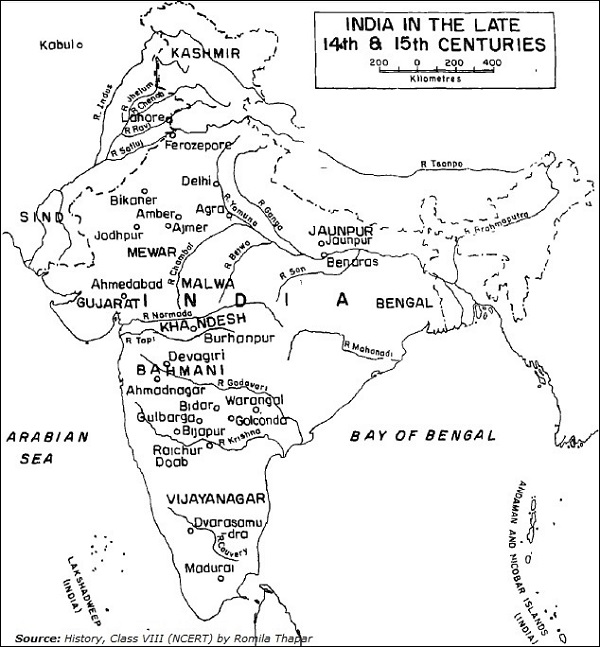
- Medieval Indian History - Home
- Kingdoms of North India
- The Rajputs
- The Invaders
- Delhi Sultanate
- The Khilji Sultans
- Tughlaq Sultans
- Lodi Sultans
- New Kingdoms
- Religion
- The Sikh Movement
- Babur’s Advent into India
- Major Battles
- Significance of Babur's Conquest
- Humayun’s Conquest
- Humayun’s Downfall
- Sur Empire
- Akbar the Great
- Early Phase of Akbar’s Reign
- Expansion of Mughal Empire
- Akbar’s Administrative System
- Akbar’s Organization of Government
- Akbar’s Relation with Neighbours
- Rebels during Mughal Empire
- Deccan & South India
- Conquest of South – I
- Conquest of South – II
- Deccan’s Cultural Contribution
- Political Development Mughals
- Nur Jahan
- Shah Jahan’s Rebel
- Mughals’ Foreign Policy
- Mansabdari System
- Social Life under the Mughals
- Nobles & Zamindars
- Trade & Commerce
- Mughals’ Cultural Developments
- Language, Literature & Music
- Religious Ideas & Beliefs
- Problems of Succession
- Aurangzeb’s Reign & Religious Policy
- North-East India
- Popular Revolts & Movements
- Rise of Maratha
- Administrative System of Shivaji
- Aurangzeb & Deccani States
- Reference and Disclaimer
Medieval Indian History - New Kingdoms
As the power of the Sultanate gradually declined, the number of new kingdoms arose in different parts of the subcontinent. Most of them began as provinces of the Sultanate, but later became independent province.
Western India
In western India, there were the kingdoms of Gujarat and Malwa. Ahmed Shah who founded the city of Ahmadabad, had strengthened the power of Gujarat.
During the reign of Hushang Shah, Malwa region became important and powerful. Hushang Shah built the beautiful fortress city of Mandu.
Gujarat and Malwa, however, were frequently at war with each other, which in reality reduced their power.
The Rajputs
There were two important Rajput kingdoms, namely Mewar and Marwar. These two were recurrently at war with each other. In spite of the fact that the two royal families had marriage relations.
Rana Kumbha of Mewar was the powerful ruler of this time. He was a man of many interests, as he was a poet, musician, and powerful ruler.
During the period, many other kingdoms had been risen in Rajasthan, Bikaner was one of them.
North India
In the north India, the kingdom of Kashmir came into prominence. Zain-ul-Abidin, also known as 'Bud Shah' (the great king) the ruler of the fifteenth century, was the most popular name of this period.
Zain-ul-Abidin encouraged the scholarship for both Persian and Sanskrit. He was a popular ruler of his time, as his major policies were concerned about the welfare of the people.
Eastern India

Jaunpur and Bengal, these two were the important regions of the Eastern India. Both of these were founded by governors of the Delhi Sultan who had later rebelled against the Sultanate.
Jaunpur was ruled by the Sharqi kings. He had a great ambition i.e. to capture Delhi, which never happened. Later, Jaunpur became an important center of Hindi literature and learning.
Bengal was ruled by kings of different races; however, largely were Turks and Afghans. All these kings were patrons of local culture and encouraged the use of the Bengali language.
South India
Bahamani and Vijayanagar were the significant kingdoms in the Deccan regions of south India. These two kingdoms had been arisen during the period of Muhammad-bin-Tughlaq.
Bahamani Kingdom
Bahamani and Vijayanagar, both these kingdoms were founded by officers of the Sultanate who had rebelled against the Sultan.
Hasan led a rebellion against the Sultan and proclaimed the independence of the Bahmani kingdom. He took the title of Bahman Shah.
The Bahmani kingdom included the whole of the northern Deccan up to the river Krishna (as shown in the map given above).
Vijayanagara Kingdom
Vijayanagara Kingdom was founded by two brothers Harihara and Bukka.
In 1336, Harihara and Bukka conquered the territory of the Hoysala (i.e. modern Mysore State) and proclaimed themselves as an Independent ruler of the Vijayanagara Kingdom.
Harihara and Bukka made Hastinavati (modern Hampi) their capital.
Apart from these big kingdoms, there were many other smaller kingdoms, especially along the eastern coast (from Orissa to Tamil Nadu). These smaller kingdoms were being frequently attacked by either the Bahmanis or the Vijayanagara rulers.
In 1370, Vijayanagara conquered Madurai. It was also active on the west coast. Meanwhile, the Bahmani kingdom was engaged in fighting against its northern neighbors, namely the kingdoms of Gujarat and Malwa.
All these kingdoms of the subcontinent became powerful, because of the handsome income that came through the land revenue and trade.
Gujarat and Bengal received big profits from overseas trade especially with western Asia, East Africa, South-East Asia, and China.
The Bahmani and Vijaynagara kingdoms also took part in the overseas trade.
Besides trade, local culture, literature in the regional language, architecture, paintings, and new religious ideas were developed in these kingdoms.